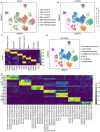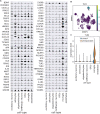Single cell transcriptome profiling of the human alcohol-dependent brain
- PMID: 32142123
- PMCID: PMC7206851
- DOI: 10.1093/hmg/ddaa038
Single cell transcriptome profiling of the human alcohol-dependent brain
Abstract
Alcoholism remains a prevalent health concern throughout the world. Previous studies have identified transcriptomic patterns in the brain associated with alcohol dependence in both humans and animal models. But none of these studies have systematically investigated expression within the unique cell types present in the brain. We utilized single nucleus RNA sequencing (snRNA-seq) to examine the transcriptomes of over 16 000 nuclei isolated from the prefrontal cortex of alcoholic and control individuals. Each nucleus was assigned to one of seven major cell types by unsupervised clustering. Cell type enrichment patterns varied greatly among neuroinflammatory-related genes, which are known to play roles in alcohol dependence and neurodegeneration. Differential expression analysis identified cell type-specific genes with altered expression in alcoholics. The largest number of differentially expressed genes (DEGs), including both protein-coding and non-coding, were detected in astrocytes, oligodendrocytes and microglia. To our knowledge, this is the first single cell transcriptome analysis of alcohol-associated gene expression in any species and the first such analysis in humans for any addictive substance. These findings greatly advance the understanding of transcriptomic changes in the brain of alcohol-dependent individuals.
Published by Oxford University Press 2020.
Figures




References
-
- Alcohol Facts and Statistics (2011) Alcohol Facts and Statistics https://www.niaaa.nih.gov/alcohol-health/overview-alcohol-consumption/al...(accessed July 16, 2019).
-
- Sacks J.J., Gonzales K.R., Bouchery E.E., Tomedi L.E. and Brewer R.D. (2015) 2010 national and state costs of excessive alcohol consumption. Am. J. Prev. Med., 49, e73–e79. - PubMed
-
- Augier E., Barbier E., Dulman R.S., Licheri V., Augier G., Domi E., Barchiesi R., Farris S., Nätt D., Mayfield R.D. et al. (2018) A molecular mechanism for choosing alcohol over an alternative reward. Science, 360, 1321–1326. - PubMed
Publication types
MeSH terms
Substances
Grants and funding
LinkOut - more resources
Full Text Sources
Medical
Molecular Biology Databases

